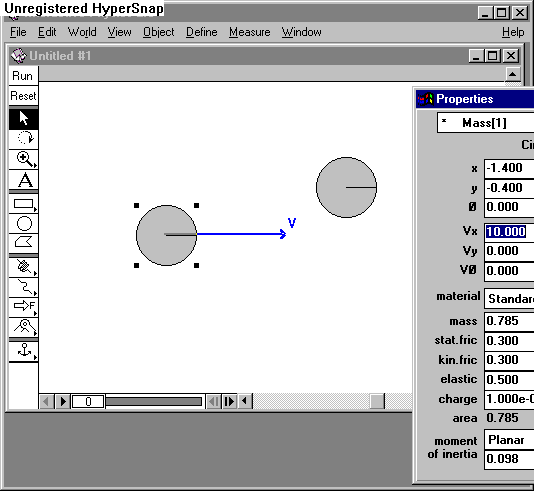
Figure: Collisions in 2-d.
Open a new simulation window. For this simulation we will turn off gravity, so that we can simulate collisions on a frictionless surface. Under the World Menu, select Gravity, then click on None. Create two identical circles. You can change the properties of the individual circles by selecting one of them, typing Alt-Enter, then changing the desired property, such as location, velocity, density, elasticity etc. Set the positions of the two circles so that one can travel with its initial velocity along the x-axis and collide with the second. Arrange the relative positions so that the two circles don't have a straight-on collision, but rather, hit at a glancing angle.
For the first series of collisions, set the elasticity coefficients for the two circles to 1 and set the frictional coefficients to zero. Collide the two objects and observe what happens. Measure the angle between the paths of the two recoiling circles. This can be done most conveniently by measuring the velocities of the recoiling circles. What do you find? Vary the degree to which the objects hit collide at glancing angles and measure the angle between the recoiling circles for 5 different collisions. Be sure to record the initial positions and velocities of the colliding objects.
Pick a convenient starting condition for the next series of collisions. Vary the elasticity coefficient of one of the circles and measure the collisions for 5 different elasticities. You should measure the angle between the recoiling balls, their speeds and the change in the kinetic energy during the collision.
For the next set of collisions vary the frictional coefficients (keep static and kinetic coefficients equal to each other for simplicity). Measure collisions with five different frictional coefficients; repeat this for two different values of the elasticities (make one of them 1.0). Calculate the total change in the translational and rotational kinetic energies during the collisions. What do you find for the angle between the paths of the recoiling circles for these collisions?
For the final set of collisions change the mass of the target circle. Choose the same starting conditions as you used above, and set the frictional coefficients to zero and choose elasticities of 1.0. Be sure to change the mass of the target by changing its density, not its size. Measure the angle between the recoiling circles for 5 different masses of the target ball, varying it from less than to more than that of the initially moving circle.
Comment on your results.